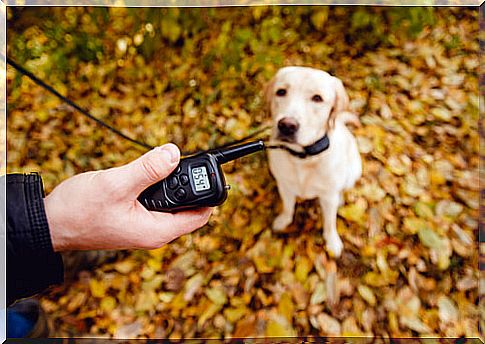When To Wear A Bark Collar?

One of the habits that dogs have that bothers us the most is barking. When a dog is very barking, some people consider wearing a bark collar. We tell you what they are and how they work.
What is a bark collar
An anti-bark collar is a type of collar that incorporates a device that operates when it detects activity in the dog’s throat. This device sends unpleasant stimuli to the animal to prevent it from barking: the most common are electric shocks, but there are also ultrasound, vibration or spray .
What these collars seek is to punish the dog when it barks, to try to stop it. It is intended that the dog associate making sounds with the throat with an unpleasant stimulus: to avoid this stimulus, it will not make sounds.
This is the theory behind these necklaces. However, it overlooks that there are many different causes for barking, and not all of them are voluntary. Barking is an element in communication, but there are many different types of barking. Barking of emotional origin, for example, cannot be avoided.
Physical consequences of wearing a bark collar
There are many types of bark collars, all of which have health consequences for dogs. This type of apparatus is located in the throat of the animal, which is one of the most delicate parts of its body: in the throat there are glands that secrete hormones, including the thyroid. In addition to being branched, some of the most important nerves in the body connect directly to the spinal cord; therefore, with the rest of the body and with the brain.
Most of these necklaces are electric. That is, they send an electrical current through the neck – and therefore the main nerves of the body – every time they detect a vibration in the neck. The manufacturers assure that it is a very low voltage: for the punishment to be effective, harm must be done, no matter how slight.

Any tension or pain in the neck has consequences in the rest of the body, since it is distributed through the spinal cord: electrical discharges cause muscle contractions, contractures, neuronal problems, tachycardias … They alter the normal functioning of the lymphatic system, the circulatory system and they can affect the metabolism, since it is in direct contact with the thyroid.
Necklaces that emit ultrasound affect the ear and can cause tinnitus, which is a very difficult condition to diagnose in animals. They affect balance and orientation. in addition to causing physical pain and deep discomfort.
Devices that spray aerosol do so directly onto the nostrils of dogs. Smell is the most important sense in these animals, and applying products as aggressive as citronella can cause loss of sensitivity or damage the scent glands. They cause pain, inability to communicate through smell, itching, and can damage the mucous membranes (they dry out or cause excessive mucus).
Altering a dog’s smell is the greatest harm that could be done to it : it is its way of seeing the world and relating to other dogs. Smell is essential for your physical and mental well-being.
The use of these devices has been shown to cause continuous stress in dogs: with stress, cortisol levels in the blood rise. Cortisol causes a bad mood, inability to rest, irritability, digestive problems (vomiting or diarrhea for no apparent reason) and, among many other things, a higher emotional state, leading to worse self-control and, therefore, worse behavior.
Psychological consequences of wearing a bark collar
But these necklaces not only have physical consequences, but also psychological ones. The use of continuous punishment on dogs not only does not work, but it exacerbates their original behavior problems.
Anti-bark collars, electric or of any other type, emit an unpleasant stimulus when the dog is going to use the throat. The dog does not know where the negative stimulus is coming from: it is on his neck and he cannot see it.

In addition, this can be activated for more reasons than barking: barks that do not come to sound, snorts or growls or an error when operating the control also causes the device to activate. In this way, the dog cannot foresee the negative stimulus, but it also does not know what causes it.
All of this translates into fear, insecurity, and stress. Stressed dogs behave worse than relaxed ones, so the collar is only making the original problem worse or creating new problems. Insecurity creates dogs with unforeseeable and unfamiliar responses.
Fear in dogs is the main cause of aggression and, therefore, attacks and bites. Faced with an unpleasant stimulus that can be avoided, dogs prefer to run away. However, since they do not know what is causing them pain and discomfort, they can only confront what they find to try to make it go away.
The psychological damages caused by the use of electric collars, such as insecurity, fear, aggressiveness, in addition to all the bad relationships that you learn during your training, can be irreversible or have a very expensive and difficult treatment. You can suffer sequelae for life.
So when to wear a bark collar?
Despite all the technological features offered by the manufacturers, such as power difference, waterproofing, remote control range … None of the anti-bark collars is able to distinguish what causes the barking in order to avoid them.

There are many different types of barking. Some are learned; We have taught dogs that by doing them they get a reward, but others are emotional – out of stress, out of pain, out of joy – that they are not voluntary and, therefore, the dog does not make them on purpose.
In the first case, an anti-bark collar would not work, since if the cause is not known, we cannot stop offering the dog its reward; This can be getting food, angering the dog on the balcony across the street, or simply getting our attention in the form of “hush!”
In the second case, the collar would not work either, because the dog cannot decide to stop barking: only by changing the emotion would its behavior be eliminated. Emotional behaviors are involuntary, in the same way that, if humans burst into tears, no matter how much they punish us, we are not able to stop. We only stop crying if we are sad: you will only stop barking when your emotional state changes.
The only way to control a dog’s barking is to uncover the root and eliminate its motivation. A bark collars are not designed for this purpose, so they are never a solution to this problem. In addition, its use can have consequences that affect the dog for the rest of its life.









